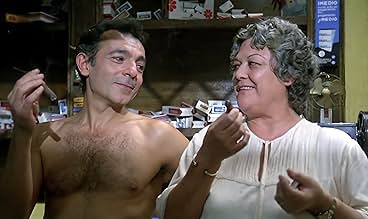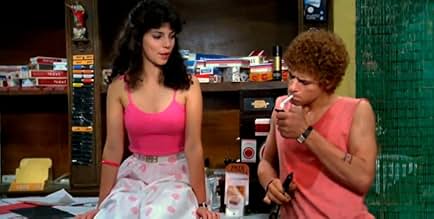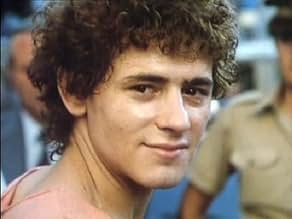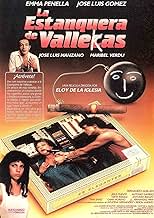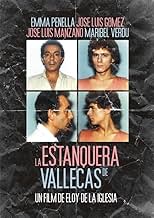La estanquera de Vallecas
- 1987
- 1h 46min
NOTE IMDb
6,2/10
1,4 k
MA NOTE
Ajouter une intrigue dans votre langueA couple of ruffians enters a tobacconist in the neighborhood of Vallecas to steal. Having failed in its intention they finish entrench themselves in the place, being surrounded by police.A couple of ruffians enters a tobacconist in the neighborhood of Vallecas to steal. Having failed in its intention they finish entrench themselves in the place, being surrounded by police.A couple of ruffians enters a tobacconist in the neighborhood of Vallecas to steal. Having failed in its intention they finish entrench themselves in the place, being surrounded by police.
- Réalisation
- Scénario
- Casting principal
- Récompenses
- 1 nomination au total
Pedro Nieva Parola
- Teniente
- (as Nieva Parola)
Tina Sáinz
- Cuñada joven
- (as Tina Sainz)
Avis à la une
I've seen this movie twice or 3 times on TV, and the situation created in it is really funny: 2 men, 1 old & 1 young decide to rubber a Tobacconist in the quarter of Vallecas (Madrid). But the owner of the establishment (a mature woman) turns out to be much braver than both of them together. Inside the tobacconist´s we can also find the owner's niece (played by a very young Maribel Verdú, a bit ugly with the irons on her teeth). The young man & her, step by step, end up falling in love with each other, and the first reaction, aggressive, defending and very tense, becomes very friendly, and they all together face the Police that came there called by the tobacconist's owner.
In just a few words, this is the case of "the chaser chased" but with a funny and good ending for them all.
Finally, I have to say that it's very entertaining and not as tough or politically incorrect as other titles by this director. If you have some spare time & don't know how to use it, take a look at this.
In just a few words, this is the case of "the chaser chased" but with a funny and good ending for them all.
Finally, I have to say that it's very entertaining and not as tough or politically incorrect as other titles by this director. If you have some spare time & don't know how to use it, take a look at this.
Stars Leandro (José Luis Gómez) , an unemployed bricklayer , and his friend Tocho (José Luis Manzano) . Both of them scheme and execute robberies to earn money , that's why they enter a tobacconist's shop in the Madrid neighborhood of Vallecas with the intention of carrying out a robbery, but the unexpected reaction of Mrs. Justa (Emma Penella) , the tobacconist , prevents them from doing so . Outside, the neighbors shout and threaten, so the assailants have no choice but to lock themselves in the premises.
A stagy dramatic comedy with thriller , romance , irony , social critic, and excessive dialogue . Eloy de la Iglesia directs and co-writes the script with his usual collaborator Gonzalo Goicoechea of this tragicomedy starring by Emma Penella, José Luis Gómez, José Luis Manzano , and a very young Maribel Verdú , all of them giving remarkable performances. The plot is simple and claustrophobic , dealing with a couple of ruffians enters a tobacconist in the neighborhood of Vallecas to rob and having failed in its intention they finish entrenching themselves in the place, being surrounded by police. This is one of the last installments of the Quinqui cinema based on the homonymous play by José Luis Alonso de Santos , of which other works have also been taken to the cinema, such as ¨Bajarse al moro¨and ¨Salvajes¨. Four protagonists are pretty well , being accompanied by a good support cast with plenty of familiar faces , such as : Fernando Guillén, Jesús Puente , Antonio Gamero, Antonio Iranzo, Azucena Hernández, Tina Sáinz , among others.
This ¨La Estanquera de vallecas¨ belonging to ¨Quinqui¨subgenre, following with the same ingredients as drug addiction , thrills , eroticism and violence . These films dealing with violent and thought-provoking look at youthful delinquency , generational problems , drugging in Spain from the 80s .¨La Estanquera de Vallecas¨ is one of several movies dealing regarding youth delinquency in Spain during the 70s and early 80s along with ¨Perros Callejeros I and II¨, ¨ Los Ultimos Golpes Del Torete¨, ¨Yo el Vaquilla¨, mostly realized by Jose Antonio De La Loma , ¨Navajeros , "Colegas", "El Pico " by De La Iglesias and especially ¨Deprisa , Deprisa¨ by Carlos Saura and later on , ¨La Estanquera De Vallecas ¨ , among others . Most films mixed exploitation , nudity , violence , with asocial commentary . Seen today, these films are unique documents on how life was lived and perceived during that period . These films were notorious in the years of the Spanish transition to democracy including provoking and polemic issues and played by unknown young people . The style is pretty much urban and realistic as well in the atmosphere as in the fresh dialog and attempted to take a position in favor of outcast people . Drugs , delinquency , and generational problems are the habitual subjects in these films and specially dedicated to the underworld of heroin and a very realistic look at drug addiction . We see their troubles growing in such streets , neighborhoods and some fine locations . These flicks show the ugliness of those "barrios" , toughness and cold existence of people , including great looks at young life and friendship in the margined side ,letting the stories flow efficiently and being realized in realistic style . Passing of time hasn't had mercy with most of those movies , but they represented a time and a way of life in the history of Spain ; and now they may seem a little bit naive. And Eloy De La Iglesia with his ¨El pico I and II¨ we watch the day-by-day of delinquents committing violent crimes , however De La Iglesia got to make a both lyric and documentary-style flick . The director created a sort of Spanish Neo-Realism by tackling the juvenile delinquency in the prison and streets from a sociological point of view . Eloy De La Iglesia chose young and natural actors as José Luis Manzano and El Pirri, who play their part to the hilt , unafraid of filmmaker's unsympathetic camera and the particularity of the characters . Here the screenplay by Gonzalo Goicoechea concerns a raid that goes wrong resulting in twisted events , though also with some ingenuousness , but in 1980, a few years after General Franco died it wasn't naive at all . It contains adequate photography with juicy atmosphere by cameraman Manuel Rojas , adding catching songs , such as : La estanquera de Vallecas written and performed by Patxi Andión ; Suspiros de España Written by J. A. Álvarez de Castro, performed by Lolita Sevilla and Mirando al mar performed by Emma Penella .
The film professionally directed by Eloy De La Iglesia , though with some flaws and gaps . De La Iglesia is a talented Spanish movies director , he began working in cinema in 1966, though he became notorious in the years of the Spanish transition to democracy with shocking and polemic films as ¨El Pico 1 and 2¨ , ¨El Diputado¨, ¨The priest , ¨Clockwork terror¨ , ¨La Otra Alcoba¨ , ¨El Techo De Cristal¨, ¨La Semana Del Asesino¨ , and after that , ¨Bulgarian lovers¨ and many others . Drugs , delinquency, terrorism and generational problems are the habitual subjects in his films , and specially dedicated to the underworld of heroin ; as well as the gay world . Seen today , his films are unique documents on how life was lived and perceived during that period . And unlike other filmmakers from the period , De La Iglesia is a frankly good filmmaker . The eye De La Iglesia had for social commentary as the attitudes of police and delinquents in realistic manner , sometimes mixed together quite badly with comedy . At his best , his films still had the gritty edge , the naturalistic approach and the poignancy that made them successful at the time . At his works , they show how thin is the line between contention and excess , between drama and exploitation . As Eloy De La Iglesia chose young and natural actors Jose Luis Manzano , Pirri, or Antonio Flores were the usual ones . All of them early deceased by drugging , including the filmmaker . Rating : 6/10 , acceptable and passable.
A stagy dramatic comedy with thriller , romance , irony , social critic, and excessive dialogue . Eloy de la Iglesia directs and co-writes the script with his usual collaborator Gonzalo Goicoechea of this tragicomedy starring by Emma Penella, José Luis Gómez, José Luis Manzano , and a very young Maribel Verdú , all of them giving remarkable performances. The plot is simple and claustrophobic , dealing with a couple of ruffians enters a tobacconist in the neighborhood of Vallecas to rob and having failed in its intention they finish entrenching themselves in the place, being surrounded by police. This is one of the last installments of the Quinqui cinema based on the homonymous play by José Luis Alonso de Santos , of which other works have also been taken to the cinema, such as ¨Bajarse al moro¨and ¨Salvajes¨. Four protagonists are pretty well , being accompanied by a good support cast with plenty of familiar faces , such as : Fernando Guillén, Jesús Puente , Antonio Gamero, Antonio Iranzo, Azucena Hernández, Tina Sáinz , among others.
This ¨La Estanquera de vallecas¨ belonging to ¨Quinqui¨subgenre, following with the same ingredients as drug addiction , thrills , eroticism and violence . These films dealing with violent and thought-provoking look at youthful delinquency , generational problems , drugging in Spain from the 80s .¨La Estanquera de Vallecas¨ is one of several movies dealing regarding youth delinquency in Spain during the 70s and early 80s along with ¨Perros Callejeros I and II¨, ¨ Los Ultimos Golpes Del Torete¨, ¨Yo el Vaquilla¨, mostly realized by Jose Antonio De La Loma , ¨Navajeros , "Colegas", "El Pico " by De La Iglesias and especially ¨Deprisa , Deprisa¨ by Carlos Saura and later on , ¨La Estanquera De Vallecas ¨ , among others . Most films mixed exploitation , nudity , violence , with asocial commentary . Seen today, these films are unique documents on how life was lived and perceived during that period . These films were notorious in the years of the Spanish transition to democracy including provoking and polemic issues and played by unknown young people . The style is pretty much urban and realistic as well in the atmosphere as in the fresh dialog and attempted to take a position in favor of outcast people . Drugs , delinquency , and generational problems are the habitual subjects in these films and specially dedicated to the underworld of heroin and a very realistic look at drug addiction . We see their troubles growing in such streets , neighborhoods and some fine locations . These flicks show the ugliness of those "barrios" , toughness and cold existence of people , including great looks at young life and friendship in the margined side ,letting the stories flow efficiently and being realized in realistic style . Passing of time hasn't had mercy with most of those movies , but they represented a time and a way of life in the history of Spain ; and now they may seem a little bit naive. And Eloy De La Iglesia with his ¨El pico I and II¨ we watch the day-by-day of delinquents committing violent crimes , however De La Iglesia got to make a both lyric and documentary-style flick . The director created a sort of Spanish Neo-Realism by tackling the juvenile delinquency in the prison and streets from a sociological point of view . Eloy De La Iglesia chose young and natural actors as José Luis Manzano and El Pirri, who play their part to the hilt , unafraid of filmmaker's unsympathetic camera and the particularity of the characters . Here the screenplay by Gonzalo Goicoechea concerns a raid that goes wrong resulting in twisted events , though also with some ingenuousness , but in 1980, a few years after General Franco died it wasn't naive at all . It contains adequate photography with juicy atmosphere by cameraman Manuel Rojas , adding catching songs , such as : La estanquera de Vallecas written and performed by Patxi Andión ; Suspiros de España Written by J. A. Álvarez de Castro, performed by Lolita Sevilla and Mirando al mar performed by Emma Penella .
The film professionally directed by Eloy De La Iglesia , though with some flaws and gaps . De La Iglesia is a talented Spanish movies director , he began working in cinema in 1966, though he became notorious in the years of the Spanish transition to democracy with shocking and polemic films as ¨El Pico 1 and 2¨ , ¨El Diputado¨, ¨The priest , ¨Clockwork terror¨ , ¨La Otra Alcoba¨ , ¨El Techo De Cristal¨, ¨La Semana Del Asesino¨ , and after that , ¨Bulgarian lovers¨ and many others . Drugs , delinquency, terrorism and generational problems are the habitual subjects in his films , and specially dedicated to the underworld of heroin ; as well as the gay world . Seen today , his films are unique documents on how life was lived and perceived during that period . And unlike other filmmakers from the period , De La Iglesia is a frankly good filmmaker . The eye De La Iglesia had for social commentary as the attitudes of police and delinquents in realistic manner , sometimes mixed together quite badly with comedy . At his best , his films still had the gritty edge , the naturalistic approach and the poignancy that made them successful at the time . At his works , they show how thin is the line between contention and excess , between drama and exploitation . As Eloy De La Iglesia chose young and natural actors Jose Luis Manzano , Pirri, or Antonio Flores were the usual ones . All of them early deceased by drugging , including the filmmaker . Rating : 6/10 , acceptable and passable.
"La estanquera de Vallecas" is the least interesting Eloy de la Iglesia movie I have seen yet. Reportedly trying to make a movie that would be more successful, de la Iglesia went for broad appeal, and yet still included his heavy dose of social realism, which didn't really mix with the humour.
The plot concerns two inept criminals who attempt to rob a store. They are a middle aged man and a young man, the latter played by de la Iglesia regular Jose Luis Manzano.
The robbery doesn't go well, as the lady behind the counter proves to be remarkably tenacious in fighting off the robbers and attracting attention to the area. Also inside the store is her niece, a young girl who at first is hampered with a dental plate marring her features and voice, but take my word for it, that is Maribel Verdu, the Spanish actress who would go on to worldwide fame in "Y Tu Mama Tambien" and "Pan's Labyrinth". It's hard to recognise her without the floatation devices she would later have strapped to her chest.
The beginning scenes are entertaining and well handled. The reaction of the store clerk to being robbed at gun point is something that, for once, feels like a realistic reaction to this situation. When the crowd gathers outside the shop, you begin to wonder what direction the social commentary will take, but you also start to wonder whether the entire movie is going to be a hostage situation, since it obviously can't sustain that to feature film length.
Then, the movie abruptly changes gears, and it becomes a sort of comedy-drama. The hostages come to like the two men who should have just given them PTSD. I don't know if it's fair to say they develop Stockholm syndrome, since they're not really hostages anymore. A large crowd has already gathered outside, including politicians as well as police.
It's funny: I was glad that the whole movie wasn't spent in the hostage situation, but what we ended up with wasn't that much better. I lost interest during these scenes.
In trying to make a broad comedy, de la Iglesia also apparently limited his usual shocking material; there is very little violence in this one, and perhaps one sexual scene, but no sex and very little nudity.
The plot concerns two inept criminals who attempt to rob a store. They are a middle aged man and a young man, the latter played by de la Iglesia regular Jose Luis Manzano.
The robbery doesn't go well, as the lady behind the counter proves to be remarkably tenacious in fighting off the robbers and attracting attention to the area. Also inside the store is her niece, a young girl who at first is hampered with a dental plate marring her features and voice, but take my word for it, that is Maribel Verdu, the Spanish actress who would go on to worldwide fame in "Y Tu Mama Tambien" and "Pan's Labyrinth". It's hard to recognise her without the floatation devices she would later have strapped to her chest.
The beginning scenes are entertaining and well handled. The reaction of the store clerk to being robbed at gun point is something that, for once, feels like a realistic reaction to this situation. When the crowd gathers outside the shop, you begin to wonder what direction the social commentary will take, but you also start to wonder whether the entire movie is going to be a hostage situation, since it obviously can't sustain that to feature film length.
Then, the movie abruptly changes gears, and it becomes a sort of comedy-drama. The hostages come to like the two men who should have just given them PTSD. I don't know if it's fair to say they develop Stockholm syndrome, since they're not really hostages anymore. A large crowd has already gathered outside, including politicians as well as police.
It's funny: I was glad that the whole movie wasn't spent in the hostage situation, but what we ended up with wasn't that much better. I lost interest during these scenes.
In trying to make a broad comedy, de la Iglesia also apparently limited his usual shocking material; there is very little violence in this one, and perhaps one sexual scene, but no sex and very little nudity.
Le saviez-vous
- AnecdotesAlthough the movie is set in Puente de Vallecas district, actually the exteriors were filmed in San Ildefonso Place, 6 km away from Puente de Vallecas. Ironically, while Vallecas is a humble neighborhood, San Ildefonso Place is in a tourist and cultural district.
- Bandes originalesLa estanquera de Vallecas
Written and Performed by Patxi Andión
Meilleurs choix
Connectez-vous pour évaluer et suivre la liste de favoris afin de recevoir des recommandations personnalisées
- How long is La estanquera de Vallecas?Alimenté par Alexa
Détails
- Date de sortie
- Pays d’origine
- Site officiel
- Langue
- Aussi connu sous le nom de
- Табачница из Вальекаса
- Lieux de tournage
- Sociétés de production
- Voir plus de crédits d'entreprise sur IMDbPro
Contribuer à cette page
Suggérer une modification ou ajouter du contenu manquant

Lacune principale
By what name was La estanquera de Vallecas (1987) officially released in Canada in English?
Répondre
